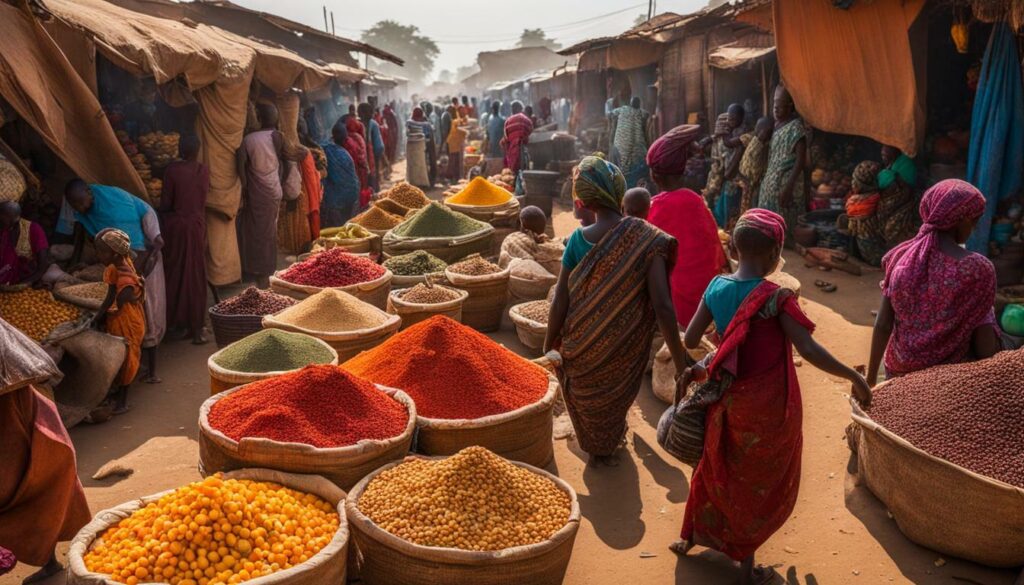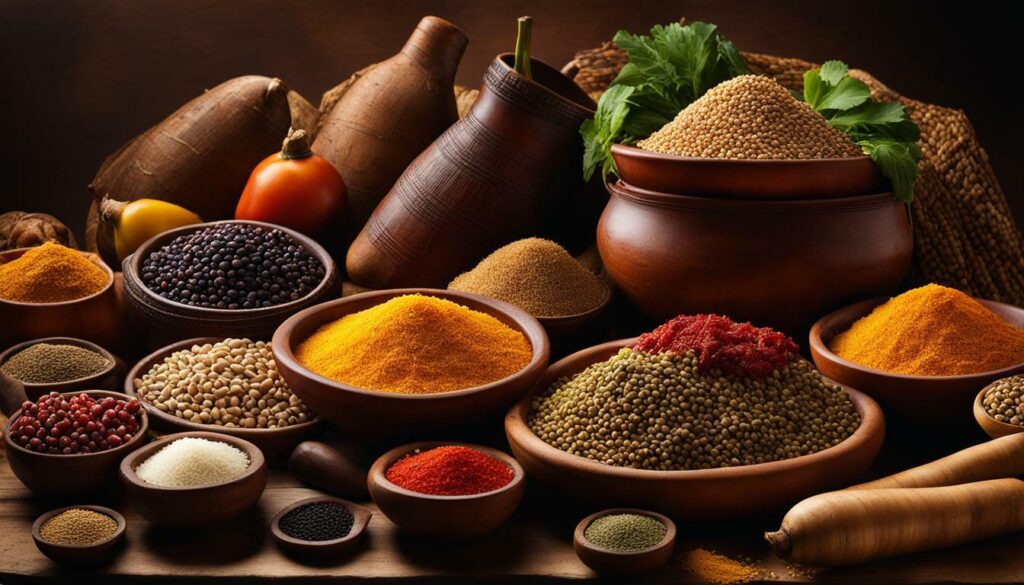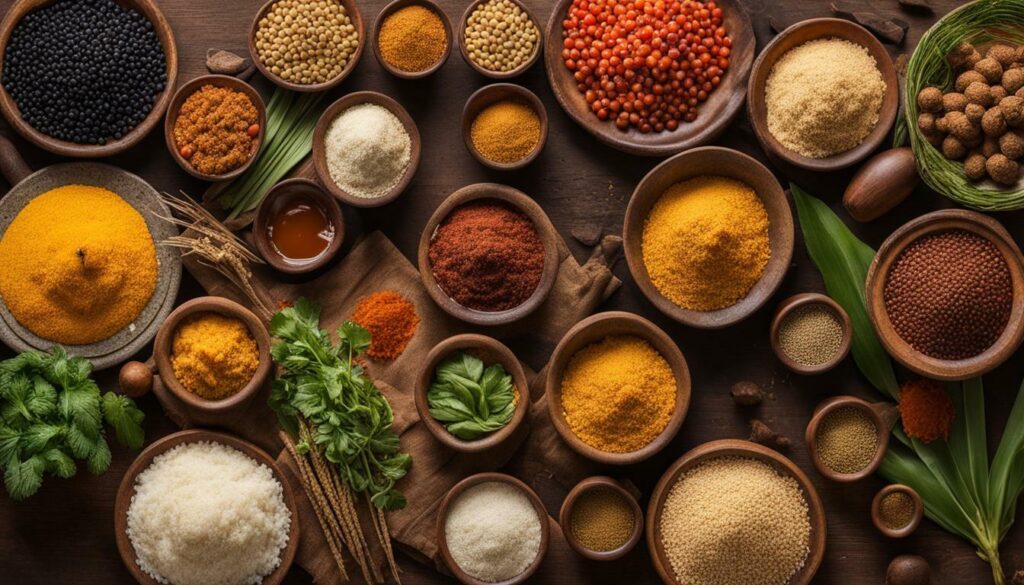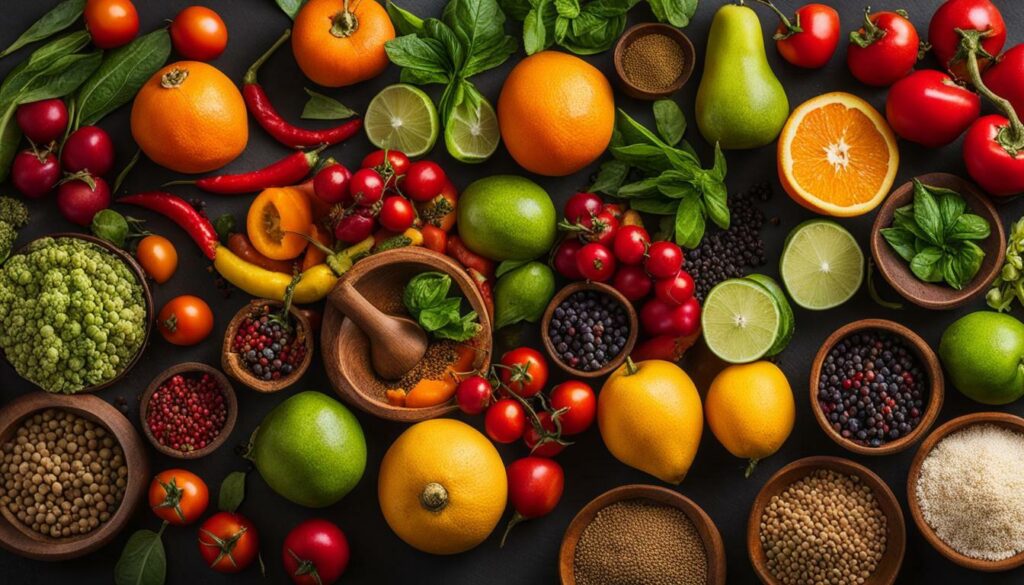Africa is a continent with a diverse culinary heritage, where food and eating practices have been shaped by centuries of history and cultural influences. The diets of different regions in Africa have evolved, influenced by factors such as adaptation to diet, geographic differences, trade, and migration. Traditional African cooking methods and ingredients vary across the continent, with staple foods, cooking techniques, and flavourings differing between North Africa, West Africa, East Africa, and Southern Africa. African cuisine has also been influenced by the introduction of New World crops. Understanding the past and present diets of Africa is essential for nutrition interventions, dietary recommendations, and national data collection.
Key Takeaways:
- Africa’s culinary heritage is diverse and shaped by centuries of history and cultural influences.
- Regional diets in Africa are influenced by factors such as adaptation to diet, geography, trade, and migration.
- Traditional African cooking methods include steaming, boiling, frying, grilling, roasting, and baking.
- Staple foods, cooking techniques, and flavourings vary across North Africa, West Africa, East Africa, and Southern Africa.
- The introduction of New World crops has had an impact on African diets.
As we explore the past and present diets of Africa, we discover a continent rich in culinary traditions, where food is not only a source of sustenance but also a reflection of history, culture, and geography. The diverse range of ingredients, cooking techniques, and flavours found in African cuisine showcases the continent’s vibrant food culture. By understanding the historical and cultural influences on African diets, we can gain insight into the importance of preserving traditional food practices and promoting healthier eating habits across the continent.
The Influence of Geography and Culture on African Diets
The diets of different regions in Africa are influenced by a variety of factors, including adaptation to diet, geographical variations, trade, and migration. Africa’s vast landscape, consisting of deserts, savannas, mountains, forests, and coastlines, has shaped the availability of certain foods in each region. For example, in coastal areas, fish is abundant and a staple in the diet, while in arid regions, grains and drought-resistant crops play a crucial role.
Cultural practices and traditions also heavily influence African diets. Each region has its own unique culinary traditions, cooking techniques, and flavour preferences. For instance, West African cuisine is known for its bold and spicy flavours, incorporating ingredients such as chilli peppers, onions, ginger, and tomatoes. In contrast, North African cuisine is characterized by its use of aromatic spices like cumin, coriander, and saffron.
African diets have also been shaped by trade and migration throughout history. The introduction of new ingredients and cooking methods from other regions and cultures has enriched African cuisine. For example, the Arab influence in North Africa introduced ingredients like couscous, dates, and almonds, while the Portuguese influence in Southern Africa introduced crops like maize and cassava.

African cuisines are characterized by a wide range of cooking methods, reflecting the cultural diversity across the continent. Traditional cooking methods include steaming, boiling, frying, grilling, roasting, and baking. These methods are employed to enhance the flavours of indigenous ingredients like grains, tubers, vegetables, legumes, and meats.
In certain regions, communal cooking techniques such as ground cooking, where food is cooked in a pit with hot stones, are common. This method is often used for special occasions and celebrations, emphasizing the communal nature of African food traditions.
| Cooking Method | Description |
|---|---|
| Steaming | Foods are cooked over direct heat, often on an open flame or grill. This method imparts a smoky flavour. |
| Boiling | Foods are submerged in boiling water until cooked. This method is commonly used for grains and vegetables. |
| Frying | Foods are cooked in hot oil or fat until crispy. This method is often used for meat, fish, and snacks. |
| Grilling | Foods are cooked in an oven or fire, and exposed to dry heat. This method is used for meats, vegetables, and nuts. |
| Roasting | Foods are cooked in an oven or fire, exposed to dry heat. This method is used for meats, vegetables, and nuts. |
| Baking | Foods are cooked in an enclosed oven, using dry heat. This method is used for bread, cakes, and pastries. |
In conclusion, the diets of different regions in Africa are shaped by a combination of geographical factors, cultural influences, trade, and migration. Understanding the diversity in African diets past and present is essential for developing nutrition interventions, dietary recommendations, and culturally appropriate programs. By appreciating the richness of African culinary traditions, we can promote healthier eating habits while preserving the cultural heritage of the continent.
Traditional African Cooking Methods and Ingredients
Traditional African cooking methods are diverse and encompass a range of techniques such as steaming, boiling, frying, grilling, roasting, and baking. These methods are not only practical but also enhance the flavours and aromas of the ingredients. The choice of cooking method often depends on the type of food being prepared and the region’s cultural traditions.
Steaming is a common cooking technique used in many African countries. It involves placing food over boiling water in a pot or using traditional steaming equipment like the Moroccan tagine. This gentle method of cooking helps to retain the natural flavours and nutrients of the ingredients.
African cuisine also incorporates various boiling methods. Boiling is typically used to prepare stews, soups, and porridges. One popular dish is Ndolé, a Cameroonian stew made with bitter leaves, nuts, and meat or fish. This cooking method allows the flavours to meld together, creating rich and hearty dishes.
Frying is another widely utilized cooking technique in African cuisine. It involves cooking food in hot oil or fat, adding a crispy texture and intense flavour. Many African snacks and street foods, such as akara (bean fritters) and puff puff (deep-fried dough balls), are prepared using this method.
Traditional African Ingredients
Traditional African cuisine relies heavily on locally sourced ingredients, showcasing the continent’s rich biodiversity. Staples like grains, tubers, and vegetables form the foundation of African dishes. Millet, sorghum, maize, and rice are commonly used in various regions, providing essential carbohydrates.
Leafy greens such as amaranth, okra, and collard greens are important vegetables in African cooking. They are often used in stews, sauces, and soups, providing vital nutrients and flavour to the meals. Other vegetables like sweet potatoes, yams, cassava, and plantains are also popular and feature prominently in many African recipes.
Meat, poultry, and fish are important sources of protein in African diets. In coastal regions, fish like tilapia and sardines are widely consumed, while in the interior, beef, goat, lamb, and chicken are common. These proteins are often cooked using various methods like grilling, roasting, and stewing to create flavorful and hearty dishes.
| Traditional African Cooking Methods and Ingredients |
|---|
 |
Regional Variations in African Diets
The diets of North Africa, West Africa, East Africa, and Southern Africa exhibit regional variations in terms of staple foods, cooking techniques, and flavourings. These variations are influenced by factors such as geography, climate, cultural traditions, and historical influences. Let’s take a closer look at the unique culinary characteristics of each region.
North Africa:
In North Africa, staple foods include couscous, bread, and wheat-based dishes. Influenced by Arab, Berber, and Mediterranean cultures, North African cuisine features a rich blend of flavours and ingredients such as spices, olive oil, and aromatic herbs. Traditional dishes like tagine, couscous with vegetables, and harira soup are popular in this region.
West Africa:
West African cuisine is known for its diverse and flavorful dishes. Staples include yam, cassava, plantain, and rice, which are often served with a variety of stews and sauces. Popular dishes include jollof rice, egusi soup, and fufu – a starchy dough made from yam, cassava, or plantains. West African cuisine is characterized by the use of spices, herbs, and chilli peppers, creating a vibrant and robust flavour profile.
East Africa:
In East Africa, staple foods consist of maize, millet, sorghum, and plantain. Ugali, a thick porridge made from maize flour, is a common accompaniment to many meals. East African cuisine features a variety of stews, curries, and grilled meats, influenced by Indian, Arabian, and Swahili culinary traditions. Dishes like injera (a sourdough flatbread) with doro wat (spicy chicken stew), samosas, and pilau rice are popular in this region.
Southern Africa:
Southern African cuisine is characterized by the use of indigenous ingredients such as sorghum, and maize, and indigenous vegetables like morogo (wild spinach) and boerewors (spiced sausage). Popular dishes include bobotie (a baked dish with spiced minced meat), biltong (dried cured meat), and potjiekos (a slow-cooked stew). The cuisine reflects the diverse cultural influences in the region, including Dutch, British, and indigenous African culinary traditions.

As we can see, the regional variations in African diets showcase the rich and diverse culinary heritage of the continent. From the aromatic flavours of North Africa to the spicy and vibrant dishes of West Africa, each region has its own unique gastronomic identity. By understanding these variations, we can appreciate the cultural significance of food in Africa and explore the wide array of flavours and ingredients that make African cuisine so unique.
Stay tuned for the next sections of our article, where we will explore the introduction of New World crops to Africa, the influence of African diets in the United States, and more!
Introduction of New World Crops to Africa
The African continent has witnessed the introduction of New World crops, such as maize, cassava, and sweet potato, which have significantly influenced African diets. These crops were brought to Africa by European explorers and traders during the colonial period and have since become integral parts of traditional African cuisine. Maize, in particular, has become a staple food in many regions, replacing indigenous grains like millet and sorghum.
The introduction of maize to Africa brought about a shift in agricultural practices, as the crop thrived in a variety of climates and required less water compared to other grains. This made it a viable option for farmers, leading to increased production and consumption. Today, maize-based dishes like pap, nsima, and banku are enjoyed across the continent.
Similarly, cassava and sweet potato have found their way into African diets, especially in areas where they are grown abundantly. Cassava is a versatile crop that can be processed into various forms, including flour and starch, which are used in cooking and baking. Sweet potato, on the other hand, is a nutritious root vegetable that is often boiled, roasted, or fried and served as a side dish or as part of a main course.

These New World crops not only provided additional sources of sustenance but also contributed to the evolution of African cuisine. They brought new flavours, textures, and cooking techniques to traditional dishes, enriching the culinary landscape of the continent. Moreover, their nutritional value added to the diversity and balance of African diets, offering essential vitamins, minerals, and carbohydrates to local populations.
As African diets continue to evolve, the incorporation of these New World crops remains significant. They have become deeply ingrained in the culture and cuisine of many African nations, reflecting the influence of historical trade and colonial interactions. Today, they are not only consumed for their taste and nutritional benefits but also valued for their role in preserving cultural heritage and identity.
African Diets in the United States
The dietary patterns among the ethnically diverse Black population in the United States are influenced by factors such as culture, nativity, and ethnicity. The African diaspora has brought with it a rich food culture that has become an integral part of the American culinary landscape. From traditional dishes to fusion cuisines, African food culture has made a significant impact on the diets of many Black Americans.
One of the key factors influencing dietary patterns among the Black population in the United States is cultural identity. African Americans, African immigrants, and Caribbean/Latin American-born Blacks each bring their unique culinary traditions to the table. Traditional dishes such as jollof rice from West Africa, jerk chicken from the Caribbean, and collard greens from the American South have become staples in many Black households.

Psychosocial factors and taste preferences also play a role in shaping the diet of Blacks in the United States. Many African Americans have a strong preference for soul food, which is characterized by the flavours of the African diaspora. This includes dishes such as fried chicken, macaroni and cheese, and collard greens. However, there is also a growing movement towards healthier eating habits, with an emphasis on incorporating more fruits, vegetables, and whole grains into the diet.
“Food is not only sustenance but also a powerful expression of cultural identity. For many Black Americans, traditional African dishes connect them to their roots and provide a sense of belonging.”
Environmental factors, such as limited access to nutritious foods in some neighbourhoods, can also influence dietary choices. This has led to the rise of food justice movements, aiming to address food insecurity and promote healthier eating options in underserved communities. Community gardens, farmers’ markets, and food education programs have emerged as important initiatives in improving access to fresh, affordable, and culturally appropriate foods.
In conclusion, the dietary patterns among the ethnically diverse Black population in the United States are shaped by a multitude of factors, including culture, nativity, and ethnicity. African food culture has become an integral part of the American culinary landscape, with traditional dishes and fusion cuisines influencing the diets of many Black Americans. However, the push for healthier eating habits and food justice initiatives are also reshaping the food choices of Black communities, promoting access to nutritious and culturally appropriate foods.
Factors Influencing Dietary Acculturation Among Immigrant Black Populations
Dietary acculturation among immigrant Black populations is influenced by a range of factors, including length of residency, age of migration, socio-economic status, and cultural factors. These factors play a significant role in shaping the dietary habits and preferences of African immigrants as they adapt to their new countries.
Length of residency in the host country is an important factor that influences dietary acculturation. Studies have shown that the longer African immigrants reside in their new country, the more likely they are to adopt aspects of the local diet. This can be attributed to increased exposure to new foods, access to cultural resources, and the influence of the local food environment.
Age of migration also plays a role in dietary acculturation. Individuals who migrate at a younger age tend to be more open to adopting new dietary patterns compared to those who migrate later in life. Younger immigrants are often more susceptible to external influences and are more likely to engage in dietary behaviours that are different from their country of origin.
Socio-economic status also influences dietary acculturation. African immigrants with higher socio-economic status have greater access to resources, which can impact their food choices. They may have more opportunities to incorporate a wider range of foods into their diets, including both traditional dishes from their home country and new foods from their host country.
Cultural factors also play a significant role in shaping dietary acculturation. African immigrants may hold strong cultural beliefs and preferences regarding food, which can influence their food choices and eating behaviours. These cultural factors may include religious practices, food rituals, and the importance of traditional foods in maintaining cultural identity.
| Factors Influencing Dietary Acculturation Among Immigrant Black Populations |
|---|
| Length of residency |
| Age of migration |
| Socio-economic status |
| Cultural factors |

Understanding the factors that influence dietary acculturation among immigrant Black populations is essential for tailoring nutrition interventions and developing culturally appropriate dietary recommendations. By acknowledging the diverse cultural backgrounds and individual experiences of African immigrants, healthcare professionals, policymakers, and researchers can ensure that nutrition programs and interventions address the specific needs and challenges faced by this population.
The Importance of Understanding African Diets for Nutrition Interventions
Understanding the diversity and influences on African diets is crucial for informing nutrition interventions, dietary recommendations, and national data collection efforts. Africa, with its rich geographic and cultural diversity, has a long history of food and eating practices that vary across regions. By comprehending the traditional dietary practices, staple foods, and cooking techniques in Africa, nutrition interventions can be developed that are culturally appropriate and effective in addressing the unique nutritional challenges faced by African populations.
Traditional African diets are characterized by a variety of foods, including grains, legumes, vegetables, fruits, and lean meats. These diets are often high in fibre, vitamins, minerals, and antioxidants, which contribute to overall health and well-being. However, rapid urbanization, globalization, and changing lifestyles have resulted in a shift towards processed foods, leading to an increase in non-communicable diseases such as obesity, diabetes, and heart disease.
To promote healthier eating habits and address the growing burden of diet-related diseases in Africa, nutrition interventions need to take into account the cultural significance of food, local food preferences, and the availability and affordability of nutritious foods. By incorporating traditional African foods and cooking methods into modern dietary recommendations, it is possible to create sustainable and culturally relevant interventions that promote better health outcomes.

In addition to dietary recommendations, understanding the diversity of African diets is essential for national data collection efforts. Accurate data on food consumption patterns, nutrient intake, and nutritional status are crucial for designing evidence-based policies and programs that aim to improve nutrition and food security in Africa. By capturing the nuances of regional variations and cultural influences on diet, policymakers and researchers can develop targeted interventions that address specific dietary needs and promote sustainable nutrition practices.
In conclusion, recognizing and understanding the diversity and influences on African diets is vital for effective nutrition interventions in Africa. By incorporating traditional dietary practices, promoting healthier food choices, and collecting accurate data, we can work towards improving the nutritional well-being of African populations and reducing the burden of diet-related diseases in the continent.
Challenges and Opportunities in Promoting Healthy African Diets
Promoting healthy diets in Africa faces challenges such as limited access to nutritious foods and the influence of Western dietary patterns. Many communities across the continent struggle with inadequate infrastructure, including a lack of clean water, refrigeration, and reliable transportation, which hinders their ability to access fresh fruits, vegetables, and lean proteins. This limited access to nutritious foods exacerbates issues of malnutrition, food insecurity, and diet-related diseases.
Furthermore, the influence of Western dietary patterns poses a significant challenge to promoting healthy African diets. As urbanization and globalization continue to shape African societies, there has been an increase in the consumption of processed and convenience foods that are high in sugar, salt, and unhealthy fats. These dietary shifts have led to an increase in noncommunicable diseases such as obesity, diabetes, and cardiovascular diseases.
However, amidst these challenges, there are also opportunities to promote and improve the healthiness of African diets. One such opportunity lies in leveraging the rich cultural food practices and traditions that have been passed down through generations. Traditional African diets are often based on whole foods, incorporating a variety of fruits, vegetables, legumes, and whole grains. By highlighting and celebrating these traditional foods, there is an opportunity to promote nutritious and culturally relevant diets.
| Challenges | Opportunities |
|---|---|
| Limited access to nutritious foods | Leveraging traditional African diets |
| Influence of Western dietary patterns | Emphasizing the value of whole foods |
| Inadequate infrastructure | Improving transportation and storage systems |
| Food insecurity | Supporting local agriculture and food production |
To address the challenges, it is crucial to invest in improving transportation and storage systems, particularly in rural areas. This would enable better distribution and preservation of perishable goods, ensuring that nutritious foods are accessible to all communities. Additionally, supporting local agriculture and food production can help tackle food insecurity by promoting sustainable farming practices and empowering local farmers.
In conclusion, promoting healthy diets in Africa requires addressing the challenges of limited access to nutritious foods and the influence of Western dietary patterns. By leveraging traditional food practices, improving infrastructure, and supporting local agriculture, there are opportunities to overcome these challenges and promote healthier eating habits. By doing so, we can improve the overall health and well-being of African populations.

The future of African diets is likely to be influenced by globalization, urbanization, and changing lifestyles, which may lead to shifts in traditional dietary practices. As people become more connected and exposed to different cultures and cuisines, there is a growing trend towards the adoption of Western dietary patterns in many African countries. The influx of fast food chains and processed foods has brought convenience but also challenges in maintaining a healthy diet.
Urbanization plays a significant role in shaping the diets of Africans, as more people move to cities in search of better opportunities. This shift often leads to changes in food preferences and consumption habits. The availability of a wide variety of foods and the influence of urban food culture contribute to the adoption of new eating patterns. Traditional foods and cooking methods may be replaced by convenient and ready-to-eat options, often high in salt, sugar, and unhealthy fats.
Changing lifestyles, including sedentary behaviours and a decrease in physical activity, also impact dietary trends. As technology advances, people are more likely to rely on processed and packaged foods that require minimal preparation. This shift towards convenience foods may lead to an increase in non-communicable diseases such as obesity, diabetes, and cardiovascular diseases.
However, amidst these challenges, there are also opportunities for promoting healthier African diets. Many organizations and individuals are working towards preserving and promoting traditional African cuisine. By rediscovering and celebrating traditional cooking methods and ingredients, African food culture can be preserved and integrated into modern eating habits. Educating the population about the importance of a balanced diet and the benefits of consuming traditional, locally sourced foods can contribute to healthier dietary practices.
Table 1: Traditional African Foods and their Modern Alternatives
| Traditional African Food | Modern Alternative |
|---|---|
| Millet and Sorghum | White bread and rice |
| Leafy Greens | Processed vegetable oils |
| Legumes | Canned beans and processed meat products |
| Fresh Fruits | Sugary snacks and drinks |
By promoting the consumption of traditional African foods, communities can not only preserve their culinary heritage but also improve their overall health. Additionally, sustainable farming practices and supporting local food systems can contribute to environmental conservation and food security. The future of African diets lies in finding a balance between embracing global influences and preserving traditional food culture.

Exploring the past and present diets of Africa reveals a rich culinary heritage shaped by diverse cultural influences, regional variations, and the introduction of new ingredients. Understanding the factors that shape African diets is vital for promoting nutrition interventions and developing culturally appropriate dietary recommendations.
Africa, as a continent, is characterized by its geographic and cultural diversity. From ancient times, food and eating have played a significant role in African history. The diets of different regions in Africa have been influenced by various factors, including adaptation to diet, geographic differences, trade, and migration.
The main meal of the day in Africa is lunch, typically consisting of a mixture of vegetables, legumes, and sometimes meat. Different meats, such as beef, chicken, and goat, are considered staples in many areas, although economic constraints limit meat consumption. In coastal regions and areas near lakes, fish is abundant and commonly enjoyed.
Traditional African cooking methods encompass a range of techniques, including steaming, boiling, frying, grilling, roasting, and baking. These methods are employed to enhance the flavours and textures of staple ingredients commonly used in African cuisine. The diets of North Africa, West Africa, East Africa, and Southern Africa exhibit variations in terms of staple foods, cooking techniques, and flavourings.
The introduction of New World crops, such as maize, cassava, and sweet potato, has had a significant impact on African diets. These crops, brought to Africa through historical transatlantic trade, have become integrated into traditional African cuisine and have contributed to the evolution of African diets over time.
Not only can African diets be observed within the continent, but they have also influenced the dietary patterns among the ethnically diverse Black population in the United States. Cultural identity, nativity, ethnicity, psychosocial factors, taste preferences, and environmental factors all play a role in shaping the diets of US-born Blacks, African-born Blacks, and Caribbean/Latin American-born Blacks.
Additionally, immigrant Black populations experience dietary acculturation influenced by factors such as length of residency, age of migration, socio-economic status, and cultural factors. These factors impact the dietary habits of African immigrants in their new countries and contribute to the cultural exchange of food traditions.
Understanding the diversity and influences on African diets past and present is crucial for informing nutrition interventions, developing culturally appropriate dietary recommendations, and enhancing national data collection efforts. By recognizing and respecting the unique culinary traditions and preferences of African populations, we can promote healthier eating habits and ensure that nutrition programs are tailored to their specific needs.
In conclusion, the exploration of African diets showcases a rich tapestry of flavours, cooking techniques, and cultural influences. By embracing the history, diversity, and future trends of African cuisine, we can foster healthy eating habits and celebrate the unique heritage embedded within each regional dish.
FAQ
What is the history of food in Africa?
Africa has a rich history of food and eating that dates back to ancient times. Culinary traditions have evolved over time, influenced by factors such as adaptation to diet, geographic differences, trade, and migration.
What is the main meal of the day in Africa?
The main meal of the day in Africa is lunch. It typically consists of a mixture of vegetables, legumes, and sometimes meat.
What are traditional African cooking methods?
Traditional African cooking methods include steaming, boiling, frying, grilling, roasting, and baking.
How do African diets vary across different regions?
The diets of North Africa, West Africa, East Africa, and Southern Africa vary in terms of staple foods, cooking techniques, and flavourings.
What are some staple foods in Africa?
Different meats are considered staples in many areas of Africa, but economic constraints limit meat consumption. Fish is abundant in coastal regions and lakes. The introduction of New World crops such as maize, cassava, and sweet potato has also influenced African diets.
How do cultural factors influence African diets in the United States?
The dietary patterns among the ethnically diverse Black population in the United States are influenced by culture, nativity, and ethnicity. Diet and dietary preferences vary among US-born Blacks, African-born Blacks, and Caribbean/Latin American-born Blacks.
What factors influence dietary acculturation among immigrant Black populations?
Dietary acculturation among immigrant Black populations is influenced by factors such as length of residency, age of migration, socio-economic status, and cultural factors.
Why is understanding African diets important for nutrition interventions?
Understanding the diversity and influences on African diets past and present is crucial for informing nutrition interventions, dietary recommendations, and national data collection.
What are the challenges and opportunities in promoting healthy African diets?
Challenges in promoting healthy African diets include limited access to nutritious foods and the impact of Western dietary influences. However, there is also an opportunity to leverage traditional food culture to promote healthier eating habits.
What are the future trends in African diets?
Globalization, urbanization, and changing lifestyles may impact traditional dietary practices and the evolution of African cuisine in the coming years.
Source Links
- https://journals.openedition.org/afriques/1857
- https://www.encyclopedia.com/food/news-wires-white-papers-and-books/africans-diets
- https://www.ncbi.nlm.nih.gov/pmc/articles/PMC6635804/



